Kelly & Walsh: Purveyor, Publisher and Printer
Established in the 1880s, Kelly & Walsh was an iconic name in the Singapore book trade until its closure in 1956. Gracie Lee traces its history as bookseller, publisher and printer.
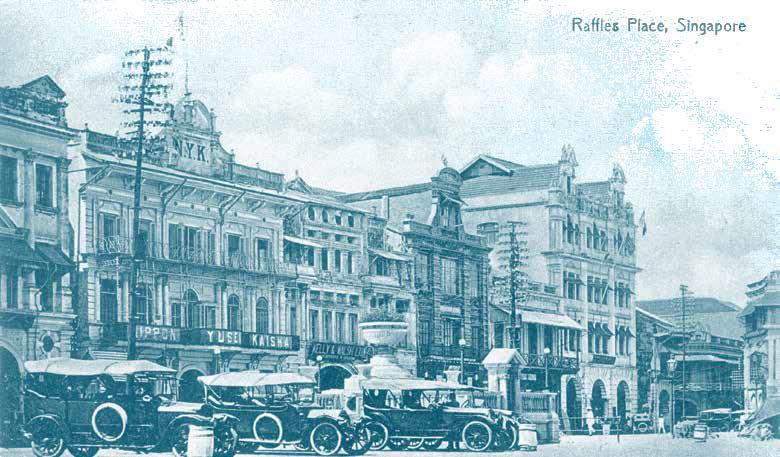 The Kelly & Walsh building (third from left) at Raffles Place, 1920s. Courtesy of National Archives of Singapore.
The Kelly & Walsh building (third from left) at Raffles Place, 1920s. Courtesy of National Archives of Singapore.It was the year 1896. Singapore was abuzz with news that King Chulalongkorn of Siam was in town for a private visit. Although the royal party was travelling incognito, their activities were closely followed and reported by the press. According to one newspaper report,1 the Siamese king, who was accompanied by three princes and the Siamese Consul, dropped in at the Kelly & Walsh bookshop at Battery Road during their tour of business establishments in town.
Kelly & Walsh was one of Singapore’s oldest and finest English bookshops. Set up in the 1880s as the local branch of the Shanghai-based book retailer and publisher Kelly & Walsh, the firm was a barometer of public reading tastes in Singapore for close to 80 years until it bowed out from the local book scene in 1956.
The bookshop was an iconic landmark in Raffles Place, delighting generations of bibliophiles and keen readers with the latest highbrowed literature and exciting potboilers from Europe, erudite volumes on Asia, and a wide variety of stationery and novelty items. The local branch also left an enduring legacy on the publishing and printing history of Singapore. For many years, Kelly & Walsh was a major producer of Malayan works and a supplier of educational materials to government schools in Singapore and Malaya.
Kelly & Walsh Ltd is Founded
Kelly & Walsh Limited was a Shanghai-based European firm formed in 1876 as a result of a merger of two booksellers, Kelly and Company and F.C. Walsh. Incorporated in Hong Kong on 1 July 1885 with the head office in Shanghai, it subsequently opened branches in Asian cities such as Yokohama, Hong Kong and Singapore.
The company’s business activities were diverse, and it took on roles such as bookseller, stationer, publisher, printer, lithographer, book binder, die engraver, colour stamper, India rubber stamp manufacturer, news agent, music seller, commission agent, and even tobacconist. The publishing arm had built up a strong reputation as a producer of quality books on East Asian subjects, especially on sinology, and was regarded as a forerunner in bringing knowledge about Asia to Western audiences.
Kelly & Walsh in Singapore
In the 1880s, Kelly & Walsh expanded its business to Singapore. There are differing accounts about when it started operations here. According to some sources, the Singapore branch made its debut as early as 1881 at Raffles Place. In yet other accounts, the firm supposedly commenced business here in 1889. However, the earliest newspaper advertisements of the Singapore branch date from 1887 onwards, coinciding with the first gazetted titles published by Kelly & Walsh in Singapore. The branch began appearing in commercial directories from 1888.
What is certain, however, is that the bookshop operated from Battery Road2 during its pioneering years before relocating to No. 32 Raffles Place in October 1898. It moved to more commodious quarters at Nos. 30–31 Raffles Place in 1916, but returned to its former premises at No. 32 in 1935, having acquired the property two years earlier.3
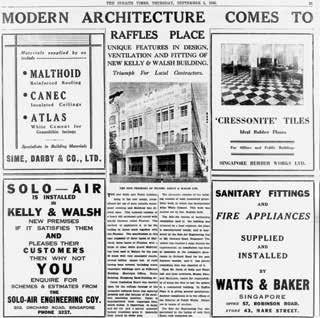 A news article on the refurbished Kelly & Walsh building at 32 Raffles Place. It was designed by Doucham Petrovitch of the architectural firm Swan & Maclaren. The Straits Times, 5 September 1935, p. 21.
A news article on the refurbished Kelly & Walsh building at 32 Raffles Place. It was designed by Doucham Petrovitch of the architectural firm Swan & Maclaren. The Straits Times, 5 September 1935, p. 21.Its homecoming to No. 32 ushered in a new chapter. The firm appointed architectural firm Swan & Maclaren and contractor Nanyang Structural Co. to rejuvenate the three-storey property. Under the guiding hand of Swan & Maclaren’s architect Doucham Petrovitch,4 the building was refurbished and modernised. The faded yellow façade gave way to grey granite plaster designs by Singapore’s resident Italian sculptor, Rodolfo Nolli,5 and the old sloping roof was replaced with a new flat roof. The building was fitted throughout with Crittall6 windows and the archways widened to allow more light to stream in.
The ground floor occupied by the bookshop was re-laid with rubber tiles, and the interior furnished with woodwork and steel shelving. Modern amenities such as a lift and solo-air, a system of ventilation which replaced fans, were also installed. In 1950, the bookshop made history when it became the first shop at Raffles Place to install air-conditioning. For customers, this was a welcome respite from the tropical heat and humidity.
Unfortunately, the halcyon days of Kelly & Walsh came to an abrupt halt with the onset of the Japanese Occupation on 15 February 1942. In September that year, its Raffles Place premises were taken over and re-opened as Seibudo Syoten, a Japanese bookshop selling mainly Japanese classics, novels and military books.
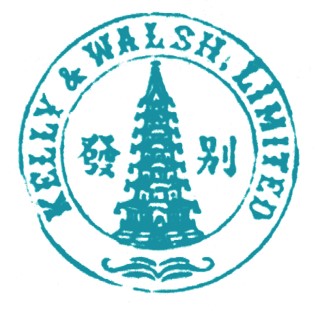 Logo of Kelly & Walsh Limited. All rights reserved, Reid, T.H. (1908). Across the Equator: A Holiday Trip in Java. Singapore: Kelly & Walsh. (Call no.: RCLOS 992.2 REI).
Logo of Kelly & Walsh Limited. All rights reserved, Reid, T.H. (1908). Across the Equator: A Holiday Trip in Java. Singapore: Kelly & Walsh. (Call no.: RCLOS 992.2 REI).After the war, Kelly & Walsh resumed business on 1 March 1946. The bookshop, along with many others, enjoyed brisk sales as people tried to replace books that they had lost during the Japanese Occupation. But a decade later, Kelly & Walsh decided to pull out from Singapore and the bookshop closed its doors permanently on 30 May 1956. In a move to liquidate its assets in Singapore, the Raffles Place property was sold to the adjoining Federal Dispensary for $1.5 million. Today, Kelly & Walsh Limited is survived only through two bookshops in Hong Kong that specialise in art books.
Purveyor of Good Books
As the leading bookshop in colonial Singapore, Kelly & Walsh was unrivalled in terms of its array of English books. It stocked a wide selection of reading materials, ranging from economically priced colonial editions,7 magazines, children’s picture books, practical books on housekeeping, cooking, self-improvement and commerce to serious literature on politics, economics and philosophy. Kelly & Walsh also carried a sensible collection of reference books to meet the thirst for knowledge in Malaya. These included handbooks on vernacular languages as well as technical works on marine engineering and metallurgy relating to shipping and tin mining – two key industries in Malaya at the time.
While the bookshop did not shy away from importing controversial titles such as Alfred Kinsey’s Sexual Behaviour in the Human Female (1953), it took pains not to display such books at its store windows nor on the shelves for fear of offending social mores of the time.
The store’s other main attraction was its display of luxury stationery items and charming art prints. From writing cases, blotters, fountain pens, diaries, bookends, and picture frames to illustrated prints and artwork, the extensive assortment of accessories made Kelly & Walsh a popular stop for gifts on special and festive occasions. Its annual display of Christmas and New Year greeting cards was also a highlight during the Yuletide season: the store displayed imported cards adorned with floral and other artistic motifs, as well as a bestselling “local” series produced in-house by Kelly & Walsh.
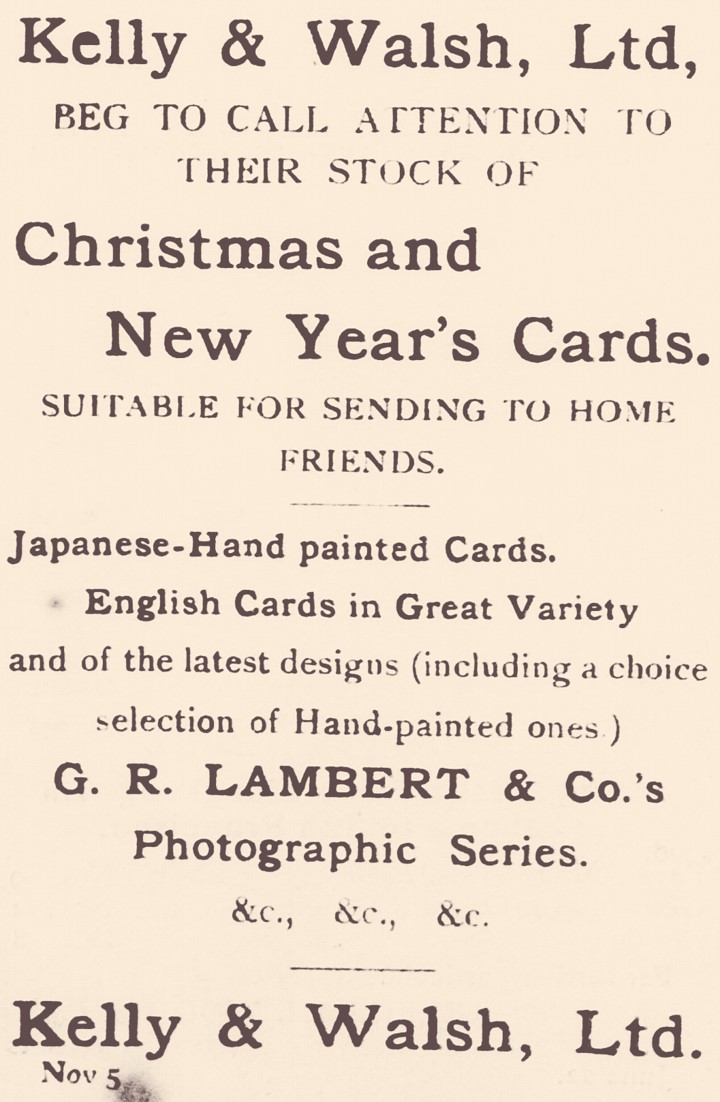 Kelly & Walsh advertising its collection of Christmas and New Year greeting cards that were “suitable for sending to home friends”. The Singapore Free Press and Mercantile Advertiser (Weekly), 1 December 1896, p. 352.
Kelly & Walsh advertising its collection of Christmas and New Year greeting cards that were “suitable for sending to home friends”. The Singapore Free Press and Mercantile Advertiser (Weekly), 1 December 1896, p. 352.The latter were collotype reproductions of Singapore scenes printed in various tints. The cards captured a motley assortment of images, such as Malay sailing crafts, views of the New Harbour (present-day Keppel Harbour), Malay kampongs, busy thoroughfares such as Battery Road and Collyer Quay, and even Malay schoolchildren and satay sellers. Printed on the cards was the greeting in Malay “Selamat Tahun Bahru” or “Happy New Year”. These cards were choice souvenirs that residents would purchase to send to family and friends abroad.
In addition to its principal business as a bookseller and stationer, the bookshop also functioned as the town’s ticketing agent for events such as music and theatrical performances, dances and balls, and flower and animal shows.
Publisher of Good Books
Perhaps the firm’s most lasting legacy in Singapore was in publishing and printing. The Singapore branch of Kelly & Walsh was a prodigious publisher and printer of works on Malayan topics and by Malayan authors. There are approximately 200 recorded titles (excluding new editions and reprints) of publications produced by the company between 1887 and the mid-1950s.8 The majority were in English, followed by Malay (both Romanised Malay and Jawi) and bilingual works in English and Malay. Only a very small number of bilingual English-Chinese and English-Tamil titles were produced, and as far as can be ascertained, none published entirely in Chinese or Tamil.
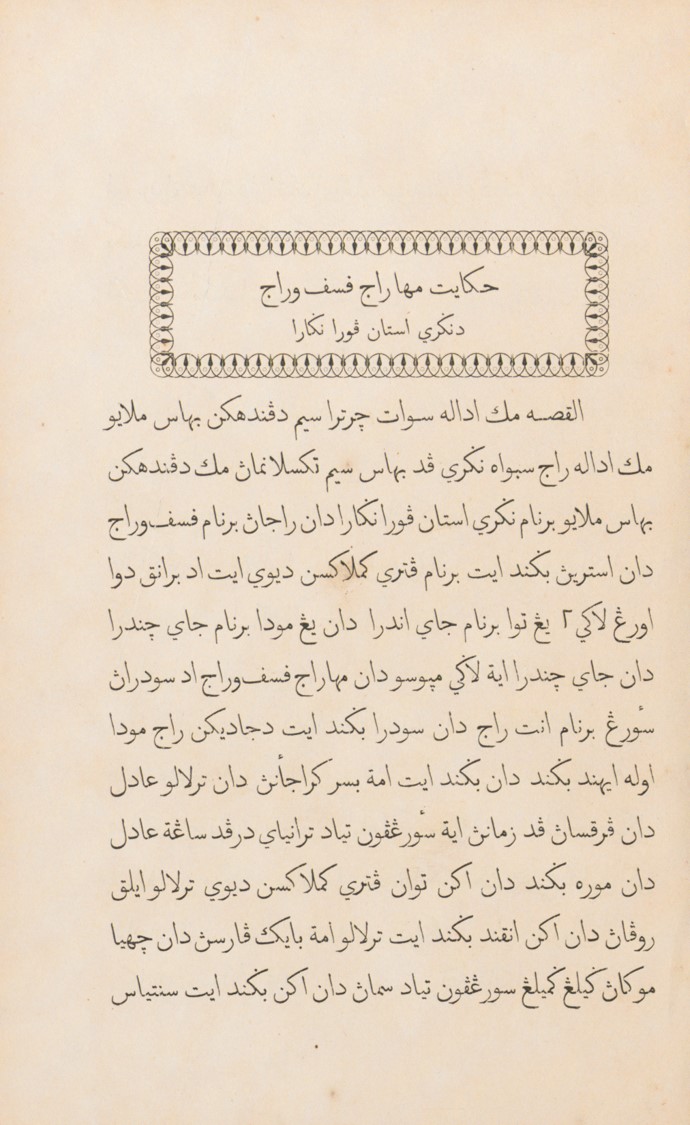 Although the majority of the publications by Kelly & Walsh were in English, the firm also produced works in Romanised Malay and Jawi. Hikayat Maharaja Puspa Wiraja di Negeri Istana Pura Negara is a Malay reader published in Jawi by Kelly & Walsh in 1900. Collection of the National Library, Singapore. (Accession no.: B18153103K; Microfilm no.: NL2554).
Although the majority of the publications by Kelly & Walsh were in English, the firm also produced works in Romanised Malay and Jawi. Hikayat Maharaja Puspa Wiraja di Negeri Istana Pura Negara is a Malay reader published in Jawi by Kelly & Walsh in 1900. Collection of the National Library, Singapore. (Accession no.: B18153103K; Microfilm no.: NL2554).The earliest recorded work published in Singapore by Kelly & Walsh was a six-page music score titled The Jubilee Waltz. It was composed by Nathan Berhardy Ruchwaldy,9 the long-time manager of the Robinson Piano Company in Singapore. The piece was performed at Government House on the occasion of Queen Victoria’s Golden Jubilee celebration in 1887. One hundred copies of the score were printed by the commercial printer, Singapore & Straits Publishing Office, and sold for 75 cents each.
The firm’s most notable publications are arguably R.J. Wilkinson’s A Malay-English Dictionary (1901–1902), which was the standard dictionary used by generations of learners of Malay, and R.O. Winstedt’s An English-Malay Dictionary (Roman Spelling) in Four Parts (1914–1917), which expanded on Wilkinson’s lexicon.
The recognition of Malay as the lingua franca in Singapore is seen in Kelly & Walsh’s publishing efforts, and evidenced by the plethora of books it published on this subject. These include Malay Orthography (1892); Kelly and Walsh’s Handbook of the Malay Language (1900); A Guide to Malay Conversations (1946); Malay for Beginners (1947); A Handbook of Spoken “Bazaar” Malay (1948); A Practical Modern Malay-English Dictionary (1952); and R.O. Winstedt’s Colloquial Malay: A Simple Grammar with Conversation (1916) and its companion volume Dictionary of Colloquial Malay (1920). There were even self-learning guides for specific uses and contexts such as A Vocabulary of Malay Medical Terms (1905), Malay Handbook for Miners (1906), Malay for Mems (1929) and A Pocket Guide to Practical Military Malay (1951). Some of these titles were so popular that they remained in print through new editions and reprints.
Kelly & Walsh was also a major publisher and supplier of educational materials for government schools in Singapore and Malaya. Many of these titles were used in elementary schools for the teaching of English and Malay languages although titles on other subjects, such as arithmetic and geography, were also published in very small quantities. These educational materials comprised textbooks, readers and teachers’ guides. According to Ian Proudfoot,10 a scholar on early Malay printed works, Kelly & Walsh and Methodist Publishing House together accounted for some 90 percent of the entire European publishing output of Malay books between 1887 and 1920. About three quarters of Kelly & Walsh’s Malay-language printing took the form of school textbooks.
Possibly the earliest educational material published by Kelly & Walsh in Singapore was English and Malay Vocabulary for Use in Schools in the Straits Settlements (1895) compiled by A.E. Pringle, the Sub-Inspector of Schools.11 The book is essentially an A–Z glossary of English words with their corresponding translations in Malay. The Singapore & Straits Publishing Office printed 2,500 copies and sold each for 20 cents. The publication went through several editions and reprints, and entered into its ninth edition in 1918.
Kelly & Walsh’s publishing interests extended beyond educational books and self-learning guides on the Malay language. It also published a number of scholarly journals and monographic series such as Studies from the Institute for Medical Research (1901–?) and the Journal of the Federated Malay States Museums (1906–41).
 A trio of books published by Kelly & Walsh. From the left: The Gate of the Far East (1908); Malayan Memories (1916); Sunny Singapore (192-?). All rights reserved, The Gate of the Far East: A Series of Views Illustrating the Chief Places of Interest in Singapore. Singapore: Kelly & Walsh (Accession no.: B02461496J, Microfilm no.: NL19878); Winstedt, R. (1916). Malayan Memories. Singapore: Kelly & Walsh (Accession no.: B02975273B; Microfilm no.: NL5876); Sunny Singapore: A Series of 38 Photogravure Views in Sepia Tone (192-?). Singapore: Kelly & Walsh (Accession no: B03061823A; Microfilm no: NL10188). Collection of the National Library, Singapore.
A trio of books published by Kelly & Walsh. From the left: The Gate of the Far East (1908); Malayan Memories (1916); Sunny Singapore (192-?). All rights reserved, The Gate of the Far East: A Series of Views Illustrating the Chief Places of Interest in Singapore. Singapore: Kelly & Walsh (Accession no.: B02461496J, Microfilm no.: NL19878); Winstedt, R. (1916). Malayan Memories. Singapore: Kelly & Walsh (Accession no.: B02975273B; Microfilm no.: NL5876); Sunny Singapore: A Series of 38 Photogravure Views in Sepia Tone (192-?). Singapore: Kelly & Walsh (Accession no: B03061823A; Microfilm no: NL10188). Collection of the National Library, Singapore.Several titles published by Kelly & Walsh also reflect the commercial interests of Malaya at the time. Some of these were: Gold and Silver Assaying with Appendix of Blowpipe Tests for the Identification of Common Minerals (1904) written by the Inspector of Mines of the Federated Malay States; Planter’s Medical Guide (1913); The Valuation of Rubber Estates for Valuers, Investors and Planters (1914); and The Improvement of Yield in Hevea Brasiliensis (1930), among others.
In addition, Kelly & Walsh released lifestyle and self-improvement books – both for light and serious reading on various genres and topics – ranging from law, sports and hobbies to cooking, literature and pictorial works that appealed to a wide variety of tastes and preferences. Examples include Cycling in Malaya (1899); Rules of Golf (1899); Amateur Gardening (1931); The Law of the Straits Settlements – a Commentary (1915); The second edition of The “Mems” Own Cookery Book (1922); and even a how-to book on that bane of anyone who loves good food – Slimming Diets for the Tropics (1936).
After World War II, Kelly & Walsh’s publishing output declined, and was confined mainly to reprints of older works. Very few new titles were released. Among its last publications was a Malayan landscape calendar published in 1953.
Printer of Good Books
Although Kelly & Walsh began publishing in Singapore as early as 1887, it did not print its own books until the firm set up a printing and book-binding department in January 1899. Prior to that, all of its printing work was contracted to commercial printers such as the Singapore and Straits Printing Office, Koh Yew Hean Press and Fraser & Neave. The firm’s printing business expanded in 190412 when it established a facility at 194 Orchard Road (where Paragon shopping centre stands today) to print its own publications as well as external jobs such as government orders.
Unfortunately, Kelly & Walsh’s printing business suffered: intense market competition and depressed prices compelled the firm to sell off its printing plant to competitor Fraser & Neave in 1924. Kelly & Walsh returned to outsourcing its printing jobs to commercial printers like Malayan Publishing House, Liang Brothers and Jitts & Co.
SOME WORKS BY KELLY & WALSH
1900: Friend Tommy and other Topics
1906: Freemasonry in Singapore
1908: Across the Equator: A Holiday Trip in Java
1912: A Christmas Number
1913: Gula Malaka
1916: Mutiny Musings and Volunteer Sketches
1919: Long-chair Malay
1926: Blonds Prefer Tuans: The Intimate Diary of a Lady of Travel
1928: Malayan Turnovers
1934: A Herd of Wild Bungalows
1938: Suleiman Goes to London
1949: Mural Ditties and Sime Road Soliloquies
 Gracie Lee is a Senior Librarian with the National Library, Singapore. She works with the rare materials collections, and her research areas include Singapore’s publishing history and the Japanese Occupation.
Gracie Lee is a Senior Librarian with the National Library, Singapore. She works with the rare materials collections, and her research areas include Singapore’s publishing history and the Japanese Occupation.
REFERENCES
1903: The year reviewed. (1903, December 31). The Straits Times, p. 1. Retrieved from NewspaperSG.
At Kelly & Walsh’s. (1921, December 21). The Malaya Tribune, p. 1. Retrieved from NewspaperSG.
Battery Road renewed. (1891, September 4). The Singapore Free Press and Mercantile Advertiser (1884–1942), p. 2. Retrieved from NewspaperSG.
Black market in books. (1947, July 20). The Straits Times, p. 5. Retrieved from NewspaperSG
Brightens Raffles Place. (1935, August 28). The Straits Times, p. 12. Retrieved from NewspaperSG.
Buckoke, L. (1950, September 6). Just looking…around the Singapore shops. Singapore Standard, p. 5. Retrieved from NewspaperSG.
Chou Sing Chu Foundation. (2016). Passage of time: Singapore bookstore stories 1881–2016 (pp. 82–87). Singapore: Chou Sing Chu Foundation. (Call no.: RSING 070.5095957 CHO)
Colony of Singapore. (1946–1956). Government gazette. Singapore: Government Printing Office. (Call no.: RCLOS 959.51 SGG)
Christmas cards. (1897, November 3). The Straits Times, p. 3. Retrieved from NewspaperSG.
Christmas cards. (1898, November 10). The Singapore Free Press and Mercantile Advertiser (Weekly), p. 5. Retrieved from NewspaperSG.
Christmas card displays. (1896, November 7). The Straits Times, p. 2. Retrieved from NewspaperSG.
Christmas preparations in Singapore. (1897, December 7). The Straits Times, p. 3. Retrieved from NewspaperSG.
Dozens want shop lease. (1956, April 9). The Singapore Free Press, p. 2. Retrieved from NewspaperSG.
Dr. Kinsey come to town – at $30 a copy. (1953, November 17). The Straits Times, p. 4. Retrieved from NewspaperSG.
‘English books good’. (1950, September 28). Singapore Standard, p. 9. Retrieved from NewspaperSG.
Former Kelly & Walsh book shop reopens. (1942, September 16). The Syonan Times, p. 4. Retrieved from NewspaperSG.
Fraser and Neave Ltd. (1924, March 19). The Singapore Free Press and Mercantile Advertiser (Weekly), p. 12. Retrieved from NewspaperSG.
Growth of Kelly and Walsh. (1916, March 22). The Singapore Free Press and Mercantile Advertiser (1884–1942), p. 7. Retrieved from NewspaperSG.
Gullick, J.M. (2001). Richard James Wilkinson (1867—1941): A man of parts. Journal of the Malaysian Branch of the Royal Asiatic Society, 74 (1), 27. Retrieved from JSTOR via NLB’s eResources website.
Impressive new building. (1935, September 5). The Straits Times, p. 15. Retrieved from NewspaperSG.
Kelly and Walsh (1969). Journal of the Hong Kong Branch of the Royal Asiatic Society, 9, 163–164. Retrieved from JSTOR via NLB’s eResources website.
Kelly & Walsh Limited Co. Ltd. (2017). About Kelly & Walsh. Retrieved from Kelly & Walsh website.
Land sale. (1904, December 14). The Straits Times, p. 5. Retrieved from NewspaperSG.
Local and general. (1887, July 27). Straits Times Weekly Issue, p. 2. Retrieved from NewspaperSG.
Makepeace, W., Braddell, R.S., Brooke, G.E. (Eds.) (1991). One hundred years of Singapore (Vol. 2, p. 202). Singapore: Oxford University Press. (Call no.: RSING 959.57 ONE)
Malay, English and Tamil bookshops. (1989, August 2). The Straits Times, p. 5. Retrieved from NewspaperSG.
Messrs. Kelly and Walsh. (1916, March 22). The Straits Times, p. 9. Retrieved from NewspaperSG.
A new Malay dictionary. (1920, October 27). The Straits Times, p. 8. Retrieved from NewspaperSG.
On the margin: Raffles Place. (1950, September 6). The Straits Times, p. 6. Retrieved from NewspaperSG.
Page 1 Advertisements Column 6: Kelly & Walsh Ltd. (1898, September 30). The Straits Times, p. 1. Retrieved from NewspaperSG.
Page 2 Advertisements Column 2: Kelly & Walsh, Limited. (1899, January 30). The Straits Times, p. 2. Retrieved from NewspaperSG.
Page 2 Advertisements Column 4: Seibudo Syoten. (1943, December 14). The Syonan Shimbun, p. 2. Retrieved from NewspaperSG.
Page 21 Advertisements Column 1: Modern architecture comes to Raffles Place: Kelly & Walsh. (1935, September 5). The Straits Times, p. 21. Retrieved from NewspaperSG.
Picturesque Singapore: Kelly and Walsh, (LTD.). (1897, October 1). The Straits Times, p. 3. Retrieved from NewspaperSG.
Property sale. (1933, March 2). The Malaya Tribune, p. 7. Retrieved from NewspaperSG.
Raffles Place building sold for $1.5 million. (1956, January 17). The Straits Times, p. 4. Retrieved from NewspaperSG.
Raffles Place developments. (1935, April 3). The Straits Times, p. 13. Retrieved from NewspaperSG.
Registry of Companies. (1916–1955). Kelly and Walsh Limited [ROC 296]. Retrieved from National Archives of Singapore website.
Round the shops: Kelly and Walsh. (1900, December 17). The Straits Times, p. 3. Retrieved from NewspaperSG.
Singapore and Straits directory, 1880–1921. Singapore: Fraser & Neave. (Call no.: RRARE 382.09595 STR; Microfilm nos.: NL1174–1190, NL7999, NL8000)
Straits Settlements government gazette, 1887–1941. Singapore: Government Printing Office. (Call no.: RRARE 959.51 SGG)
The Battery Road improvements. (1890, August 6). The Singapore Free Press and Mercantile Advertiser (Weekly), p. 12. Retrieved from NewspaperSG.
The Christmas shows at the stores. (1897, December 20). Mid-Day Herald and Daily, p. 2. Retrieved from NewspaperSG.
The Singapore and Malayan directory. (1921–1926) Singapore: Fraser & Neave. (Call no.: RRARE 382.09595 STR-[LKL]; Microfilm nos.: NL1191, NL1192, NL1993)
The stores and Christmas. (1889, December 24). The Singapore Free Press and Mercantile Advertiser (Weekly), p. 791. Retrieved from NewspaperSG.
T. F. Hwang takes you down memory lane: Old publishers and booksellers. (1989, September 16). The Straits Times, p. 22. Retrieved from NewspaperSG.
Where there is no cold weather….(1889, November 5). The Singapore Free Press and Mercantile Advertiser (Weekly), p. 550. Retrieved from NewspaperSG.
Winstedt’s Malay dictionary. (1914, April 25). The Straits Times, p. 9. Retrieved from NewspaperSG.
Wright, A., & Cartwright, H.A. (Eds.) (1908). Twentieth century impressions of British Malaya (p. 679). London: Lloyd’s Greater Britain Pub. (Call no.: RCLOS 959.51033 TWE)
Xmas quiet. (1933, December 11). The Straits Times, p. 10. Retrieved from NewspaperSG.
Yuletide in Singapore: Kelly and Walsh. (1899, December 14). The Straits Times, p. 3. Retrieved from NewspaperSG.
NOTES
-
The King of Siam. (1896, May 19). The Singapore Free Press and Mercantile Advertiser, p. 3. Retrieved from NewspaperSG. ↩
-
The firm was first located at No. 5 Battery before moving to No. 6. ↩
-
The property was acquired for $345,000 and comprised the unit numbers 32, 32-1, 32-2, 32-3, 32-4 and 33 Raffles Place, as well as No. 1, 1-1, 3, 3-1, 5, 5A, 5B, 5C, 7, 7A, 7B, 9, 9-1, 9A, 9B, 11, 11A, 11B, 13, 13A, and 13B Change Alley. ↩
-
Petrovitch also designed the Tanjong Pagar Railway Station. ↩
-
Best known for his work at the Old Supreme Court (present-day National Gallery Singapore). ↩
-
Crittall is an iconic brand of windows that was founded in the UK in 1884. ↩
-
Colonial editions are editions of books sold at lower prices for distribution in colonial markets. ↩
-
This figure was derived through a count of the titles listed in the Memoranda of Books Registered in the Catalogue of Books Printed in the Straits Settlements and in WorldCat (http://www.worldcat.org). ↩
-
A copy of this title is held by The British Library. ↩
-
Proudfoot, I. (1986). A formative period in Malay book publishing. Journal of the Malaysian Branch of the Royal Asiatic Society, 59 (2) (251), 101–132, p. 114. Retrieved from JSTOR via NLB’s eResources website. ↩
-
A copy of this edition is held in the Emil Lüring collection of the Goethe University Library in Frankfurt. ↩
-
Construction of the printing plant began in 1903. ↩

